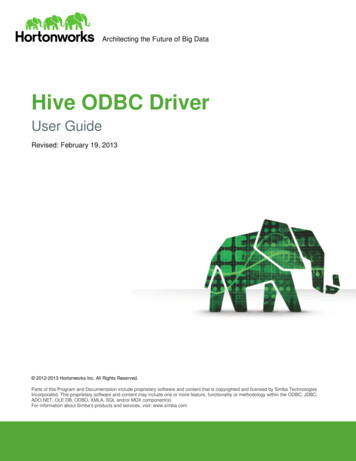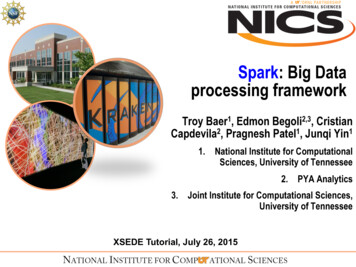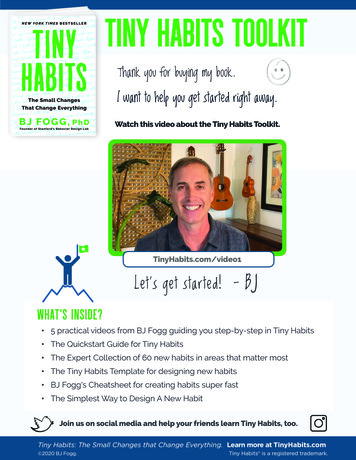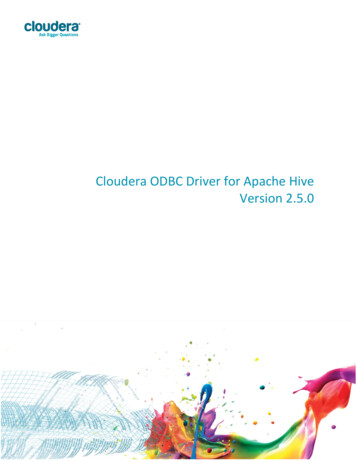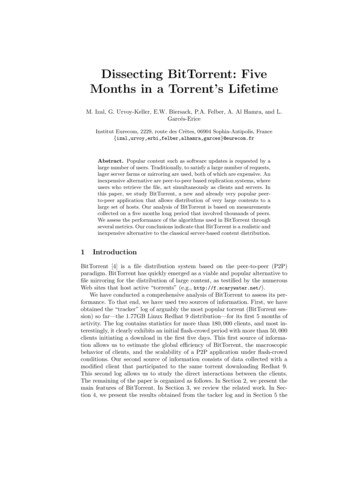Transcription
HIVE Tracker: a tiny, low-cost, and scalable device forsub-millimetric 3D positioningDarío R. QuiñonesGonçalo LopesDanbee KimCentre for Biomaterials and TissueEngineering, Universitat Politècnicade València, Spaindaquco@doctor.upv.esKampff Lab, Sainsbury WellcomeCentre, University College LondonLondon, UKg.lopes@ucl.ac.ukKampff Lab, Sainsbury WellcomeCentre, University College LondonLondon, UKdanbee.kim@ucl.ac.ukCédric HonnetDavid MoratalAdam KampffSorbonne University,UPMC, CNRS, ISIRParis, Francecedric@honnet.euCentre for Biomaterials and TissueEngineering, Universitat Politècnicade València, Spaindmoratal@eln.upv.esKampff Lab, Sainsbury WellcomeCentre, University College LondonLondon, UKadam.kampff@ucl.ac.ukFigure 1: Hive Tracker prototype, with a US 25 cent coin for size comparison.ABSTRACTCCS CONCEPTSPositional tracking systems could hugely benefit a number of niches,including performance art, athletics, neuroscience, and medicine.Commercial solutions can precisely track a human inside a roomwith sub-millimetric precision. However, these systems can trackonly a few objects at a time; are too expensive to be easily accessible; and their controllers or trackers are too large and inaccuratefor research or clinical use. We present a light and small wirelessdevice that piggybacks on current commercial solutions to provideaffordable, scalable, and highly accurate positional tracking. Thisdevice can be used to track small and precise human movements,to easily embed custom objects inside of a VR system, or to trackfreely moving subjects for research purposes. Human-centered computing Virtual reality; Computing methodologies Motion capture; Hardware Wireless devices; Software and its engineering Open sourcemodel; Information systems Global positioning systems;Permission to make digital or hard copies of all or part of this work for personal orclassroom use is granted without fee provided that copies are not made or distributedfor profit or commercial advantage and that copies bear this notice and the full citationon the first page. Copyrights for components of this work owned by others than theauthor(s) must be honored. Abstracting with credit is permitted. To copy otherwise, orrepublish, to post on servers or to redistribute to lists, requires prior specific permissionand/or a fee. Request permissions from permissions@acm.org.AH2018, Feb. 7-9 2018, Seoul, Korea. 2018 Copyright held by the owner/author(s). Publication rights licensed to Association for Computing Machinery.ACM ISBN 978-1-4503-5415-8/18/02. . . DSWireless-Sensor, Open Source, Virtual Reality, Motion Capture, Lowcost, Indoor, Tracker, NeuroscienceACM Reference Format:Darío R. Quiñones, Gonçalo Lopes, Danbee Kim, Cédric Honnet, DavidMoratal, and Adam Kampff. 2018. HIVE Tracker: a tiny, low-cost, and scalable device for sub-millimetric 3D positioning. In Proceedings of The 9thAugmented Human International Conference (AH2018). ACM, New York, NY,USA, 8 pages. ONHumans and other animals use bodies as our primary interfacewith the outer world, and as a powerful tool for expressing ourinner worlds [1, 27, 28, 32]. Movement is therefore a phenomenonof interest to many, such as neuroscientists, surgeons, engineers,makers and artists. Though we have long appreciated movement ona macro scale, it has become increasingly clear that much could begained from studying movement in greater detail and with higherprecision.
AH2018, Feb. 7-9 2018, Seoul, Korea. Darío R. Quiñones, Gonçalo Lopes, Danbee Kim, Cédric Honnet, David Moratal, and Adam Kampff1.1Applications in performing arts andathleticsTwo areas with long-standing interests in the precise study ofhuman movement are the performing arts and athletics. In the1920s, Rudolf Laban, a dance artist and theorist, developed with hiscolleagues a written notation system to precisely and accuratelydescribe movement in terms of body parts, actions, floor plans,temporal patterns, and a three-dimensional use of space [17]. Thishas evolved into the modern-day Labanotation, or KinetographyLaban. However, many movement artists find Labanotation toocomplex and cumbersome for easy daily use. These days it is muchmore common to use videos to record, analyse, and teach the specific movements of performing artists and athletes. The increasedprevalence of cheap video recording devices, especially phone cameras, has increased the use of this technique. But even high quality,state-of-the-art video recording technology struggles to capture themovements of aerial artists, acrobats, and other circus performers;the finer details of object manipulations performed by jugglers andathletes (e.g. finger placement and movements for optimal archerytechnique); and the tiny, fast movements of smaller body parts oftenfound in hip hop and modern dance.1.2Applications in neuroscience and medicineThe fields of neuroscience and medicine are also interested in precisely recording and analysing movement, both for research andfor clinical applications. A fundamental question in neuroscienceis how nervous systems generate and execute movement goals.Historically, neuroscientists have prioritized the collection of cellular signals when answering research questions, so experimentsare designed around the need to keep an electrode, or other datacollecting device, stuck in the animal’s head. This means that mostneuroscience experiments study animals that are either held inplace (“head-fixed”) or tethered to a wire. However, a growing bodyof evidence supports the idea that cellular activity in the brain issignificantly different when an animal is actively and freely movingin three dimensions through complex physical spaces, as opposedto when it is head-fixed or tethered to a wire. [10–14, 22]. Studies ofthe development and degeneration of nervous systems in humansalso show that nervous systems are profoundly affected by themovements and physical contexts of their bodies [2, 18, 25]. Better systems for precise positional tracking in humans and animalswould significantly impact the scientific questions that neuroscientists and clinical researchers could ask.1.3Current state-of-the-art in positionaltrackingAll of these areas would benefit hugely from having greater access to precise movement tracking. Motion capture systems, ormo-cap for short, are the current state-of-the-art for recording themovements of people and objects. However, current motion capturetechnologies require multiple specialized cameras, in addition to awhole slew of accessories, which unfortunately make these systemsinaccessibly expensive and bulky. Industry standards for mo-cap,such as VICON and OptiTrack [3, 29], require a minimum investment of 10-15 thousand USD in order to assemble a viable system.Another option out on the market are inertial measurement units,or IMUs, which combine accelerometers, gyroscopes and magnetometers to track small and fast movements [8, 9, 30, 31]. Despitetheir sensitivity and speed, such IMUs do not measure absoluteposition, only relative motion. This means that to recover absoluteposition one must integrate the measured motion over time. Evensmall measurement errors will accumulate during this integrationprocess, a phenomenon referred to as “drift”. This makes IMUsinadequate for precise, continuous tracking of natural movementsequences. Another currently available alternative (at the time ofwriting) for motion tracking is Microsoft’s Kinect, a consumer level3D motion-sensing camera device for video game consoles. Usingdepth information and machine learning, the Kinect can infer inreal-time the pose (position and orientation) of a human body located in front of the camera. However, a single Kinect cannot trackmotion in 360 degrees, as it was originally designed to track themovements of gamers facing a video game display. Some motiontracking systems combine Kinects and IMUs in an attempt to supplement one technology’s weaknesses with the strengths of theother [24], but IMUs will always drift, and multiple Kinects willalways be required to gain 360 degree tracking. While all thesesystems have found a niche, and are of great use to the military andentertainment industry, they are neither affordable to most artists,athletes, researchers, or clinicians, nor accurate enough for use inresearch or clinical settings [16].1.4Affordable, smaller, and more scalableSimpler solutions are already coming out of artistic research, wearable applications and even implant experimentations [5, 19, 23].Building upon this line of work, we present here an affordable, compact, and scalable positional tracking device called “Hive Tracker”(Figure 1), which can measure movement with sub-millimetric precision along six degrees of freedom; allows for untethered movementwithin a 5x5x5 m 3 space; connects easily and simply to virtual reality; and can scale up to as many devices as desired. This approachwould allow the niches described above to take advantage of precisepositional tracking technology, and opens the door to a plethora ofnew human augmentation applications.2MATERIALS AND METHODSWe present here the details of our multi-component system, composed of commercial products as well as custom devices and software. We first developed and benchmarked a small proof-of-conceptof the system using an off-the-shelf microcontroller board describedin Section 2.2.2. We present below some of this benchmarking data,which we used to constrain the subsequent design of the first Hivetracker prototype, described in Section 4.Figure 2: Overall system overview
HIVE Tracker: a tiny, low-cost, and scalable device for sub-millimetric 3D positioningFigure 2 shows an overview of the complete signal processingpipeline, which we describe in the following section.2.1Valve tracking systemThe Hive Tracker is a data-collection device that piggybacks on acommercial virtual reality system developed by Valve (HTC VIVE).The commercial system consists of a headset, two hand controllers,and two light-emitting devices (“lighthouses” or “base stations”).Each lighthouse contains an LED matrix and two mirrors mountedon high precision rotors. In order to achieve sub-millimetric precision, this system needs to be set up in a space no larger than a 5x5x5meter cube. We reverse-engineered the communication protocolbetween the lighthouses and the commercial devices in order toreplace the commercial devices with custom devices optimized tofit our needs.The signal from the lighthouses is composed of four components[Table 1], which enable the system to synchronize the two lighthouses and to track devices within the VR space (Figure 3). Whenthe system initializes, the lighthouses are automatically assigned aslighthouse A and B. To synchronize the two lighthouses, lighthouseA first emits a flash of light with known pulse length. Soon after,lighthouse B emits a similar flash of light, as described in Table 1.The length of the flash determines which lighthouse will start thelaser plane sweep, and whether that sweep will be horizontal orvertical. (Figure 4)2.2Signal processing2.2.1 Photodiode circuit. In both our proof-of-concept and ourfirst PCB prototype, we used the Chiclet, a sensor processing development board made by Triad Semiconductors. The first-generationPulse start, µs04001222 - 67778333Pulse length65 - 13565 - 135 101556µs Source stationABA or BMeaningSync pulseSync pulseLaser plane sweepEnd of cycleAH2018, Feb. 7-9 2018, Seoul, Korea.of the Chiclet uses the TS3633 integrated circuit (IC). The IC converts a weak and noisy analog signal (obtained with the photodiode)to a digital signal which is simpler to use with a microcontroller. Itprovides both high-gain noise filtering and envelope detection ofpulsed IR light that is incident on the photodiode.2.2.2 Acquisition Hardware: Teensy. The Hive Tracker proof-ofconcept was developed on a Teensy 3.2 (PJRC.COM, LLC., Sherwood, Oregon, USA). This 35x17mm microcontroller uses an ARM1cortex M4 processor overclocked at 120MHz to reduce interrupthandling latency. The Teensy timestamps the digital signals comingfrom the TS3633 and sends them to a computer to be convertedinto angles (Section 2.2.3).2.2.3 Acquisition Software: BONSAI. For data collection, integration, and online visualization, we used the Bonsai visual programming language [7]. Photodiode activation timestamps werecollected and serialized into User Datagram Protocol (UDP) packetsvia the Open Sound Control (OSC) protocol [26]. These packetswere streamed wirelessly into the host computer using WiFi. To reconstruct the position and orientation of each HiveTracker, we usedthe VR package of the Bonsai programming language to access theestimated 6 DOF (degrees of freedom) location of each lighthousein parallel with the OSC messages.2.2.4 Triangulation algorithm. For each light signal sequence(Table 1), each lighthouse will first flash, then scan a beam of lighteither horizontally or vertically [21]. Every photodiode gets hit byboth the flash and the scans, but the light hits each photodiode atdifferent times. Each lighthouse sweeps at 120Hz. The “incidentplane” is the plane defined by the angle between a photodiode anda lighthouse (Figure 3). The cross product of the normals of thehorizontal and vertical incident planes defines a vector (“incidentline”) between the tracking device and the lighthouse. The absolute position and orientation of each lighthouse is given by the1 AcornRISC Machine - RISC: Reduced Instruction Set ComputerTable 1: Activation TimingsFigure 3: Representation of the computed lines in the 3Dspace. Picture represents how two intersected planes represent a 3D line pointing to each base station.Figure 4: Light signal sequences (4 are shown): wide pulsesare base station flashes and short pulses are laser planescans.
AH2018, Feb. 7-9 2018, Seoul, Korea. Darío R. Quiñones, Gonçalo Lopes, Danbee Kim, Cédric Honnet, David Moratal, and Adam Kampffcommercial system, which allows us to project the incident linesfrom each lighthouse into the global coordinate system. The closestpair of points between these two incident lines defines the absolutelocation of a tracking device [4], which can be determined at 30 Hz(Table 1).3 RESULTS AND DISCUSSION3.1 Tracking inside an ideal roomWe first compared the Hive Tracker proof-of-concept against thehand-held controllers of the commercial Valve tracking system inan ideal room. We taped a non-regular hexagonal shape on thefloor of the testing room, then traced this shape by hand withboth devices, recording the devices’ positions using Bonsai. Theacquired trajectories were overlapped to compare the accuracy ofthe commercial controller (32 photodiodes) against that of the firstHive Tracker proof-of-concept (1 photodiode). In this comparison,we used the commercial device as our baseline “ground truth”. Sincethe tracing movements were parallel to the floor plane, we usedonly the sensors’ X and Y axes for this benchmark (Figure 5).To quantify the comparison, we fit a polygon shape to the tracking data from the commercial device. We then compared this trajectory to the average traces from the Hive Tracker by calculating theaverage distance of each point in the tracker trajectory to the fittedhexagon. The results of this comparison are shown in Figure 5. TheHive Tracker proof-of-concept, which uses only one photodiode,had an average error on the order of 10 mm more than the averageerror of a commercial tracker.3.2Tracking in a non ideal roomWe then tested the Hive tracker proof-of-concept in the worstpossible scenario: in a 1.2x1x1.5m 3 space with a glass floor. Inthis situation the proof-of-concept was not able to achieve goodFigure 5: Accuracy comparison between a commercial controller and Hive Tracker proof-of-concept in an ideal room.Traces from both devices are superimposed over a photo ofa polygon taped to the floor. Blue commercial controller,Orange Hive Tracker, Green tape on the floor.Figure 6: Accuracy comparison between commercial controller and Hive Tracker proof-of-concept in a non-idealroom. Traces from both devices are superimposed over aphoto of a polygon taped to the floor. Blue commercialcontroller, Orange Hive Tracker, Green tape on the floor.accuracy, due to the short distances between the lighthouses andthe reflection of the laser light on the glass floor (Figure 6).3.3Light reflectionsLight reflections are a potential source of errors in this setup. As thelaser plane (see Table 1) sweeps across the VR space, it is possible forlight to bounce off a wall (or any shiny surface) and hit a photodiodesensor. Figure 7 shows false detections in the photodiode signal. Wehave addressed this issue in our first PCB prototype by adding extraphotodiode sensors for more redundancy in the system. One canfurther shield the photodiodes from non-direct hits by embeddingthem in a shallow depression.Figure 7: Reflections off the walls cause undesired pulses (asterisk) in the photodiode signal (compare to Figure 4).
HIVE Tracker: a tiny, low-cost, and scalable device for sub-millimetric 3D positioning3.4Tracking refresh rateAnother limitation of the proof-of-concept was the refresh rateof positional measurements. In order to find the closest pair ofpoints between the two incident lines from the lighthouses usingonly one photodiode, we needed to collect light data for at leastfour full cycles from each lighthouse. This means that the HiveTracker proof-of-concept updates positional tracking measures at30Hz (See Fig.4). This limitation can be addressed by using multiplephotodiodes placed in a known geometric configuration relativeto each other. In this way, the sequence of incident lines hittingeach of the photodiodes in a single sweep can be used to constrainestimations of the absolute position and orientation of the HiveTracker. This situation can be framed as a “Perspective-n-Point”problem, or the more general problem of estimating the positionand orientation of a calibrated camera based on the projection of 3Dpoints in the world onto that 2D camera image. Given this framing,we can consider each lighthouse as an ideal pinhole camera wherethe 2D-to-3D point correspondences are known exactly. Efficientalgorithms to solve this problem for 3 or more points have beenintroduced by the computer vision community. [6]We can further constrain the reconstruction by using inertialmotion measurements to estimate motion over time. This makesit possible to reconstruct the position and orientation of an entireHive Tracker device from single sweeps at 120Hz. These insightsmotivated the development of the first Hive Tracker PCB prototypedescribed in the next section.4PCB PROTOTYPE AND NEXT STEPSOur tests with the Hive Tracker proof-of-concept confirmed ourinitial suspicions, namely that we would need to use more photodiode sensors. However, this also increases the computational loadon the microcontroller processing system, as multiple photodiodesensors may be hit simultaneously. To address this, our first PCBprototype includes a dedicated system for processing in parallel thephotodiode signals. The hardware, firmware and software designsare open source and available online: http://HiveTracker.github.io4.1AH2018, Feb. 7-9 2018, Seoul, Korea.HardwareIncreasing the number of photosensors increases the computationalload on the system’s processing units. The most common way todeal with this is to use FPGA (Field Programmable Gate Array) processors, which enable true hardware parallel processing. However,we found a simpler approach to achieving the necessary parallelization while maintaining an extra-compact board, such thatthe device does not hamper free movement. We chose to use thenRF52 by Nordic Semiconductors (Oslo, Norway), a "System onChip" (SoC) that replaces the functionality of the FPGA with a Programmable Peripheral Interconnect (PPI). The nRF52 also includesa BLE (Bluetooth Low Energy) and an ARM cortex M4 core.Figure 8 shows the design of the first custom board, with 5 Chiclet connectors. On the top side of the board, shown on the right ofthe figure, the largest component (labeled "MCU" for Micro Controller Unit) is the ISP1507 by Insight SIP (Sophia Antipolis, France).This 8 x 8 mm2 system-on-package (SoP) includes the nRF52, itsnecessary passives, a high accuracy crystal resonator to define theFigure 8: PCB design (left: bottom layer, with the photodiode connectors - right: top layer includes MCU, BLE, IMU,battery connector, button, LEDs, etc.)radio communication speed, and a low power oscillator, which enables the microcontroller to save power while in deep sleep. Therectangular chip above the MCU is the Bosch BNO055 (Reutlingen,Germany) , an IMU SoC with a 3D accelerometer, a 3D gyroscope, a3D magnetometer, and an ARM cortex M0 to perform sensor fusion.The other parts are the battery connector to connect LiPo batteries,a regulator, an RGB LED, a button, and 5 analog inputs that can behave as any GPIO (General Purpose Input/Output - to connect otherMCU, sensors, etc). This first custom miniaturization prototype isfar from cost-optimal, as the Chiclets are quite expensive. We havekept them in our design because their reliability is proven, and thecables connecting them to our PCB give us greater flexibility whenplacing the photodiodes. The next iteration of the Hive Trackerwill not use Chiclets; instead, it will use the TS4231, a new IC byTriad Semi, and through-hole photodiodes that can accommodatecustom orientations.4.2FirmwareThe embedded software (firmware) configures the Triad Semi IC,processes the signal, merges it with the IMU data, and then sendsit to a computer or a smartphone over BLE. This firmware fulfills the same function as the Teensy on the first proof-of-concept.The Teensy measures timing differences using interrupts, but thismethod can degrade the positioning accuracy. In the time it takes tohandle an interruption, other light signals may have occurred. Asmentioned earlier, an FPGA would solve this problem, but wouldmake the Hive Tracker bulkier. While trying to keep the PCB small,we were able to validate that a rare feature of the MCU, the Programmable Peripheral Interconnect (PPI), could connect the edgedetector and the capture register. This connection would normallyneed to happen via a CPU or FPGA, but using a PPI allows peripherals such as GPIOs and timers to interact autonomously with eachother using tasks and events. The lack of interruptions makes itpossible to simultaneously process up to 5 signals, which wouldimprove robustness to potential occlusion. For a trackable object todetect IR signals in any 3D orientation, the geometric placement
AH2018, Feb. 7-9 2018, Seoul, Korea. Darío R. Quiñones, Gonçalo Lopes, Danbee Kim, Cédric Honnet, David Moratal, and Adam KampffFigure 9: Programmable peripheral interconnect (PPI), Nordic Semiconductors [20]of at least 4 photodiodes must be on the vertices of a tetrahedra.Figure 9 shows how these peripherals are connected.This embedded software is developed using the SDK provided byNordic Semiconductors, the MCU manufacturer, to allow optimalperformances. It is also Arduino compatible, to allow the researchcommunity, makers, or artists to experiment openly and freely.4.3Size/accuracy trade-offOur custom PCB prototype can fit into a bounding box volume about100 times smaller than the one necessary to enclose a commercialtracking device, and our device weighs about 10 times less than thecommercial tracker (Figure 10). These improvements in size andweight did cost some tracking precision (see section 3), but sinceour error calculations were made with the proof-of-concept, whichused only one photodiode, we can treat those error measurementsas a “worst-case scenario”. The increased number of photodiodesin our PCB prototype can only improve the precision of the proofof-concept.These reductions in size and weight make the Hive Tracker muchmore convenient to use in a wider variety of human applications.Because it is not only small but also quite flat, the Hive Trackercan be integrated into clothing, gloves, or shoes worn by circusperformers, theater artists, and dancers to capture their movementsin real-time without hindering them. The Hive Tracker can also beeasily integrated into objects manipulated by jugglers and athletes,in order to track and capture the movements of their props inaddition to their bodies.For medical and neuroscience research, which primarily use rodent subjects, the size and weight reductions are crucial. In neuroscience research, ethical review boards generally find it acceptableto use implants that do not exceed 10% of the body weight of theanimal to be implanted. The average adult laboratory rat weighsbetween 250 to 500 grams [15], and the average adult rat headmeasures about 5 cm in length [15]. Given that the Hive Trackermeasures 2.4 cm x 1.4 cm and weighs 8 grams, the Hive Tracker isalready both small and light enough to be approved for use withrats, who are often implanted with devices that weigh 15 to 25grams.The accuracy of positional tracking that the Hive Tracker needsto achieve in order to be useful to medical and neuroscience researchvaries depending on the research question. Most research questionsrequire a system that can precisely track the 3-dimensional movements of the whole body and the direction and orientation of thehead. Current setups in neuroscience and medical research usually use video cameras to create a record of animal behavior, fromwhich body trajectory and head movements are later extractedoffline. This is both computationally and financially costly, and somany researchers simplify or ignore completely the behavioral validations required to thoroughly investigate their hypotheses. Evenwith the proof-of-concept’s “worst-case scenario” precision, theHive Tracker would already greatly increase researchers’ ability toperform behavioral validations with a similar level of rigor as othercontrols currently used in neuroscience and medical research.4.4CostTo produce the first 10 prototypes, the cost of the current versionwas about 75 USD, as opposed to 99 USD for the commercial tracker.This cost will be improved in our next version as the Chiclets won’tbe necessary anymore, so we can easily anticipate the cost of eachHive Tracker to be under 60 USD, especially if we produce them inlarger quantities.4.5AutonomyVarious batteries can be used, but the one shown in figure 10 hasa capacity of about 100mA. Given that our maximum power consumption is estimated to be about 40mA, this version of the HiveTracker can run autonomously for at least 2 hours, depending onthe usage. Embedded devices are in sleep mode most of the time,so the autonomy would greatly depend on the desired refresh rate.In addition, we do not need to process nor transmit data duringperiods of inactivity. For the applications mentioned in this paper,the inactivity rate might range from 10% to 90%, so the Hive Trackercould potentially run autonomously for 20 hours.5CONCLUSIONThis paper showed an affordable and scalable custom positionaltracking device that can integrate easily with a commercial consumerlevel VR system. The Hive tracker is totally wireless and batterypowered, which allows us to attach this small tracker to humans, animals, or even objects without interfering with natural movementsand complex interactions. Furthermore, there is no limit to thenumber of trackers that can be used simultaneously. Based on theproof-of-concept presented here, we plan to use the Hive Trackerin a variety of applications, including neuroscience experimentsof natural behavior; tracking and capturing object manipulations;3D haptics in VR; and detailed and precise documentation of movements in artistic and clinical settings. These applications of theHive Tracker can directly enhance our understanding of interactive movement and behaviour in humans and other animals. Thus,devices like the Hive Tracker are crucial to the kinds of research necessary for developing the next generation of human augmentationtools.
HIVE Tracker: a tiny, low-cost, and scalable device for sub-millimetric 3D positioningAH2018, Feb. 7-9 2018, Seoul, Korea.Figure 10: Size/weight comparison. Commercial tracker: 10 x 10 x 4.2 420cm3 ; 85g. Hive Tracker: 2.5 x 1.5 x 1.1 4.13cm3 ; 8g.ACKNOWLEDGMENTSThe authors would like to thank Yvonne Jansen and Alexis Polti fortheir support and expertise in the making of the latest Hive Trackerprototype. The authors would also like to thank NeuroGEARS Ltdfor the financial support and all the help that they provide. DaríoR. Quiñones is supported by grant “Ayudas para la formación depersonal investigador (FPI)” from Universitat Politècnica de València. Darío also acknowledges financial support from the UniversitatPolitècnica de València, through the “Ayudas para movilidad dentro del Programa para la Formación de Personal investigador (FPI)de la UPV". David Moratal acknowledges financial support by theSpanish Ministerio de Economía y Competitividad (MINECO) andFEDER funds under grant BFU2015-64380-C2-2-R. This work wasalso partially performed within the Labex SMART (ANR-11-LABX65), supported by French state funds managed by the ANR underreference ANR-11-IDEX-0004-02.REFERENCES[1] Michael L. Anderson. 2003. Embodied Cognition: A field guide. Artificial Intelligence 149 (2003). https://doi.org/10.1016/S0004-3702(03)00054-7[2] Nicholai A Bernstein. 1996. Dexterity and its development. https://doi.org/10.1080/00222895.1994.9941662[3] Chien-Yen Chang, Belinda Lange, Mi Zhang, Sebastian Koenig, Phil Requejo,Noom Somboon, Alexander A Sawchuk, and Albert A Rizzo. 2012. Towardspervasive physical rehabilitation using Microsoft Kinect. In Pervasive ComputingTechnologies for Healthcare (PervasiveHealth), 2012 6th International Conferenceon. IEEE, 159–162.[4] David H Eberly. 2006. 3D game engine design: a practica
HIVE Tracker: a tiny, low-cost, and scalable device for sub-millimetric 3D positioning AH2018, Feb. 7-9 2018, Seoul, Korea. Figure 2 shows an overview of the complete signal processing pipeline, which we describe in the following section. 2.1 Valve tracking system The Hive Tracker is a data-collection device that piggybacks on a

